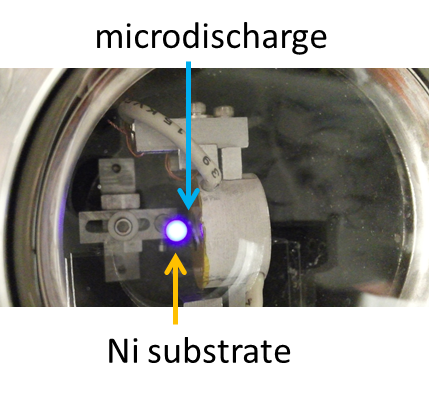Non-Thermal Microplasmas
As the term seems to imply, microplasmas are small, with at least one dimension in the sub-millimeter range. Microplasmas are used for surface modification, disinfection, decontamination, fuel reforming, nanoparticle synthesis, as light sources, and in a multitude of other applications. The advantages include operating at atmospheric pressure, portability, and lower power consumption. But their small size and variability make characterization difficult and many questions remain about the plasma and its interactions with surfaces.

The purpose of this project is to create a non-thermal microplasma source to serve as a model to gain insight into the properties of microplasmas and the basics of their interactions with a surface of a catalyst such as Ni, for example. The plasma sources under the investigation explore the hollow cathode and hollow anode geometries and a Ni substrate as the third biased electrode. The sources operate in the pressure range of 2 - 8 torr in the atmosphere of argon, nitrogen, carbon dioxide, and a methane/carbon dioxide mixture. Once the source is characterized, it can be used in an environmental electron microscope (EEM) for in-situ investigation of surface modification of the Ni substrate. In-situ evaluation of surface modifications induced by reactive plasma-surface interactions is an important part of the fundamental studies of the processes at plasma-surface interfaces. A previous in-situ investigation involved an atmospheric pressure discharge microcell placed in an electron microscope to investigate the sputtering on gold foil in argon plasma. Using the microplasma source inside an EEM makes it possible to study nanomaterial deposition of the surface of a catalyst.
In addition to providing a plasma source that can be used in an EEM, the 2 - 8 torr range provides an advantage of better control over the chemical composition of the plasma gasses. The microplasma source operating as a constricted glow discharge provides a useful physical model for the theoretical efforts of understanding the electron distribution function for plasmas containing fast beam electrons. Different plasma regimes may be explored such as high density non-equilibrium discharges and sources of high energy ions and electrons. .